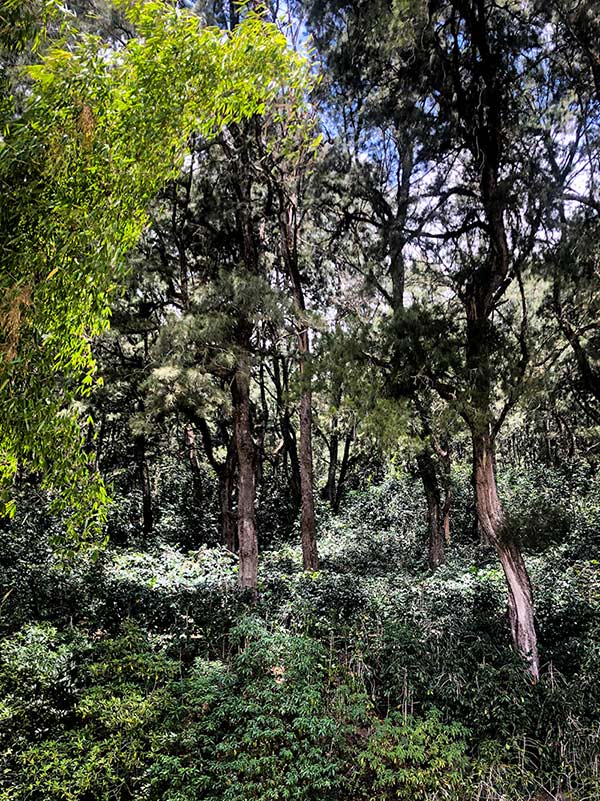Since enhancing its reputation as a newly established speciality coffee origin, more interest is being given to Timor-Leste and in particular, the way in which coffee is grown here. Join us as we take a deeper dive into shade grown coffee and find out how our partner roasters are helping our partner farmers to increase their yields.
What came first? The coffee tree or the shade tree?
When we first visited Letefoho in 2017 and made the 3km trek to my work colleague’s ‘coffee forest’, we were taken aback by the shade trees that dominated the skyline and then soon thankful for the resulting canopy that provided welcome relief from the intense mid-day sunshine. Seeing coffee trees for the first time in such a habitat soon made me realise that it wasn’t just me who was benefiting from the shade. As my senses started to adjust to their new surroundings, I could see that in addition to the small green and orange cherries patiently preparing themselves for the impending coffee harvest, there were also other crops growing in this lush and fertile habitat as well as a cacophony of bird song coming from the branches of the towering casuarina trees above. At that time, I didn’t know much about agroforestry, intercropping or natural eco-systems (and still have a lot to learn about this), but I did instantly realise that these forests were truly special and that Letefoho’s coffee farmers had developed a symbiotic relationship with their incredible environment.
I had assumed that these forests had been cultivated by Mother Nature and that over time, farmers had learnt to make good use of their surroundings, working out the best way to grow crops within the forests over generations. When I spoke to my colleague about this and shared my thoughts, I was surprised to learn that the entire forest (shade trees included) we had visited was grown by his grandfather, only 2 generations previously. Whilst he agreed that some forests would have occurred naturally, most had in fact been carefully planned and patiently nurtured by farmers and their families.

So, how on earth do you go about planting a coffee forest?
It’s probably easier if we let Simao answer that question so if you click on the video to your left, he’ll show you exactly how he and his colleagues create a coffee forest. As Simao explains, current government guidelines suggest that for every hectare of land, 200 shade trees should be planted.
The shade tree of choice is the leguminous Casuarina which is preferred for the speed at which it grows, the excellent shade which it gives and its ability to nourish the soil with nitrogen. Once the shade seedlings have been planted other crops are also planted alongside in order to aid with soil health and then it is a matter of being patient. It takes 5-years for the newly planted shade tree seedlings to get to a suitable height where they start to give shade from the hot sun and it’s at that point that coffee seedlings can then be planted.
The Ministry of Agriculture recommends that 1 hectare of land can accommodate between 1,600 – 1,800 coffee seedlings and these need to be spaced approximately 2 metres apart when put in the ground. After this, other crops are also interspersed alongside the coffee including yam, arrow root, bananas and mangoes which in addition to adding more nutrients to the soil will also serve as daily food staples. Then it is just a question of waiting for another 4-years until the coffee trees are ready to be harvested for the first time.
So, to summarise, it takes a total time of 9 years to grow an East Timorese coffee forest, from the point at which the first shade tree seedling is planted to the point at which cherries can eventually be picked.
Challenges
One of the things we’re currently supporting our partner farmers with is the growth of new coffee forests with those communities who have land that is yet to be used for coffee production. More importantly perhaps, we are trying to support every individual household that we work with so they can increase their yield per hectare through the replacement and rehabilitation of old coffee trees. The Indonesian occupation of Timor-Leste (1975 – 2002) took its toll on the coffee plantations of regions such as Letefoho and many coffee trees were left to grow wild with little maintenance or care given. The result of this sometimes means trees have been left to grow to as tall as 3 metres and lower branches do not produce any significant quantity of fruit. Until these trees are rehabilitated or replaced, the farmers of Letefoho will find it difficult to optimise their yield potential and subsequently maximise their household income.
How roasters are supporting us
For every 10kg of green beans that partner roasters purchase from us, we have pledged to plant one shade or coffee tree seedling at our nursery in Letefoho. We have so far sold 14 tonnes of green beans from the 2023 harvest which translates to 1400 seeds being planted. These will be carefully nurtured by our man on the ground Simao and when the time is right, we will share these with our parter farmers across all groups, prioritising on those households whose coffee forests need the most immediate attention. Our goal is to ensure that in the not too distant future, our partner farmers will have healthy, well-maintained coffee trees yielding a realistic 3kg per tree. If we’re able to do this, that could mean that each hectare of land with 200 shade trees and 1800 coffee trees could have the potential of producing 5,400 kilos of cherry which would be a significant increase in current production.
If you would like to know more about this initiative or become a partner roaster with Karst, get in touch to arrange a video call at the farms in Letefoho during this coming harvest season and we’ll be more than happy to show you around Letefoho’s stunning coffee forests (internet willing!).
Obrigado barak!
Stewart
